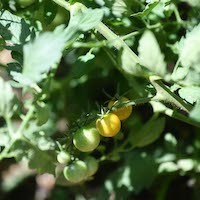A Garden Grows on Morningside Campus
A professor in engineering (with a long family history of gardening) finds a small, empty plot of land on campus and grows a lush garden.

While most occupants of Columbia’s Morningside campus have vacated because of the coronavirus pandemic, one professor from the School of Engineering and an investigator at the Zuckerman Institute, J. Thomas Vaughan, is cultivating a small plot of land that he named the "George Washington Carver Victory Garden" on the north side of the grounds. Eileen Barroso, the University Photographer, recently caught up with him to find out more about his curious garden and his family’s connection to George Washington Carver.
Q: Why did you start the garden?
A: I love to garden. I've kept a vegetable garden since I was 6. I used to "work" in my grandmother Mary's seed store when I would visit her in Tuskegee, Alabama, where I grew up. She taught me how to plant and grow turnip greens—my first vegetable row. The seed store is still in the family.

Q: When did you start planting?
A: I started the garden this spring, in March, just as COVID-19 was ramping up and Columbia was ramping down. In the past, it has been the domain of ad hoc student garden clubs. I started by finding Helen Bielak, operations manager of environmental stewardship, online to ask permission to plant a garden since the students were no longer on campus because of COVID-19. Then, she introduced me to Richard Bussert, facilities director, who has helped me with the garden.
Since we began, three additional gardeners have joined: Elaine Perlman of Teachers College, Jay Walker at Columbia College and Elise Engler of CUNY. They’ve all helped out with planting and weeding. Elaine created the row labels and garden sign. Jay helped build the pea and tomato trellises and Richard provided general facilities support and backup, from new dirt to hoses to tools to seeds and helped to dig the garden.

Q: What kinds of vegetables, fruits and flowers have you planted?
A: We’re growing a mesclun mix of leaf lettuce, spinach, collards, kale, broccoli, beets, carrots, spring onions, beans, peas, squash, corn, basil, mint, peppers, tomatoes and cucumbers. We also planted a border of zinnias and marigolds.

Q: Who gets to keep the food?
A: Everybody asks this question. The farmers get fed first, though we're happy to share when asked.
Q: What do you like most about it?
A: I started it out of my interest in gardening, something I've done in my backyard since boyhood as I mentioned earlier. Not having a yard here, this plot of ground in the middle of Columbia campus, right in front of my office building is a godsend. Being in such a public space, I've serendipitously enjoyed another role, that of garden interpreter.

As I'm working in the garden, a steady stream of curious passersby ask questions like the ones you're asking here. But my favorite visitors are the many young children coming by with their parents, some daily, to watch the garden grow. They know all of the vegetables by name, by sight and by culture, from seed to fruit. This up-close familiarity with their veggies not only promotes interest, but also makes the healthy food more delicious at the dinner table, according to their parents.
Q: Did you put that sign up about George Washington Carver? If so, why?
A: As I mentioned earlier, I learned my gardening skills—from what to grow to how to grow it—from my family in Tuskegee, Ala., My grandfather, H.A. Vaughan (see photo of his store above) was a partner with Dr. Carver, the famous agriculturalist at Tuskegee Institute. He was the county agricultural extension service agent for Macon County, Ala., and some of the funding that supported Dr. Carver's agricultural experiments flowed through my grandfather.

My grandfather supplied many of the seeds, fertilizers and farming implements to Dr. Carver and area farmers, many at the recommendation of Dr. Carver who was working hard to diversify agriculture away from a one-crop (cotton) economy. My grandfather had a large farm and was an experimentalist and early adaptor of Dr. Carver's agricultural developments. I still have and manage some of that farm today. In a fairly direct line of mentorship, I learned and loved many of Dr. Carver's vegetable varieties and gardening methods early and have continued them in my life, if for more of a hobby than a career.
In the depths of World War I and the Spanish Flu, Congress enacted a War Gardens program. Dr. Carver, in close advisement to Congress on this, recommended the name "Victory Garden" instead. The stated mission of the Victory Garden program was to provide sustenance and to boost morale during this difficult period for our country and the world. These gardens became an international sensation and were practiced in many other countries around the world. They were revived in the U.S. in the Great Depression and again in World War II. For all of these reasons and more, like the Black Lives Matter movement, we thought it appropriate and timely to name the garden the George Washington Carver Victory Garden. Elaine made the temporary sign. My daughter, Dylan, a graduate student at Teachers College, is working on a more polished and permanent one.
J. Thomas Vaughan is a professor in the Columbia School of Engineering and Applied Sciences, Department of Biomedical Engineering, and director of the Columbia Magnetic Resonance Research Center. He is also a professor of radiology at the Vagelos College of Physicians and Surgeons as well as a member principal investigator and MR platform director at the Mortimer B. Zuckerman Mind Brain Behavior Institute. His favorite title, he said, is the "gardener."